2009 CHRYSLER 300 SRT steering wheel
[x] Cancel search: steering wheelPage 333 of 493

WARNING! (Continued)
•Anti-lock system (ABS) cannot prevent the natural
laws of physics from acting on the vehicle, nor can
it increase braking or steering efficiency beyond
that afforded by the condition of the vehicle
brakes and tires or the traction afforded.
•The ABS cannot prevent accidents, including
those resulting from excessive speed in turns,
following another vehicle too closely, or hydro-
planing. Only a safe, attentive, and skillful driver
can prevent accidents.
•The capabilities of an ABS equipped vehicle must
never be exploited in a reckless or dangerous
manner, which could jeopardize the user’s safety
or the safety of others.
All vehicle wheels and tires must be the same size and
type and tires must be properly inflated to produce
accurate signals for the computer.
Anti-Lock Brake Light
The ABS light monitors the Anti-Lock Brake Sys-
tem. The light will come on when the ignition
switch is turned to the ON position and may stay on for
as long as four seconds.
If the ABS light remains on or comes on while driving, it
indicates that the Anti-Lock portion of the brake system
is not functioning and that service is required. However,
the conventional brake system will continue to operate
normally if the BRAKE warning light is not on.
If the ABS light is on, the brake system should be serviced
as soon as possible to restore the benefits of Anti-Lock
brakes. If the ABS light does not come on when the
Ignition switch is turned to the ON position, have the
bulb repaired as soon as possible.
If both the Brake Warning Light and the ABS Light
remain on, the ABS and EBD systems are not functioning.
Immediate repair to the ABS system is required.
STARTING AND OPERATING 331
5
Page 335 of 493
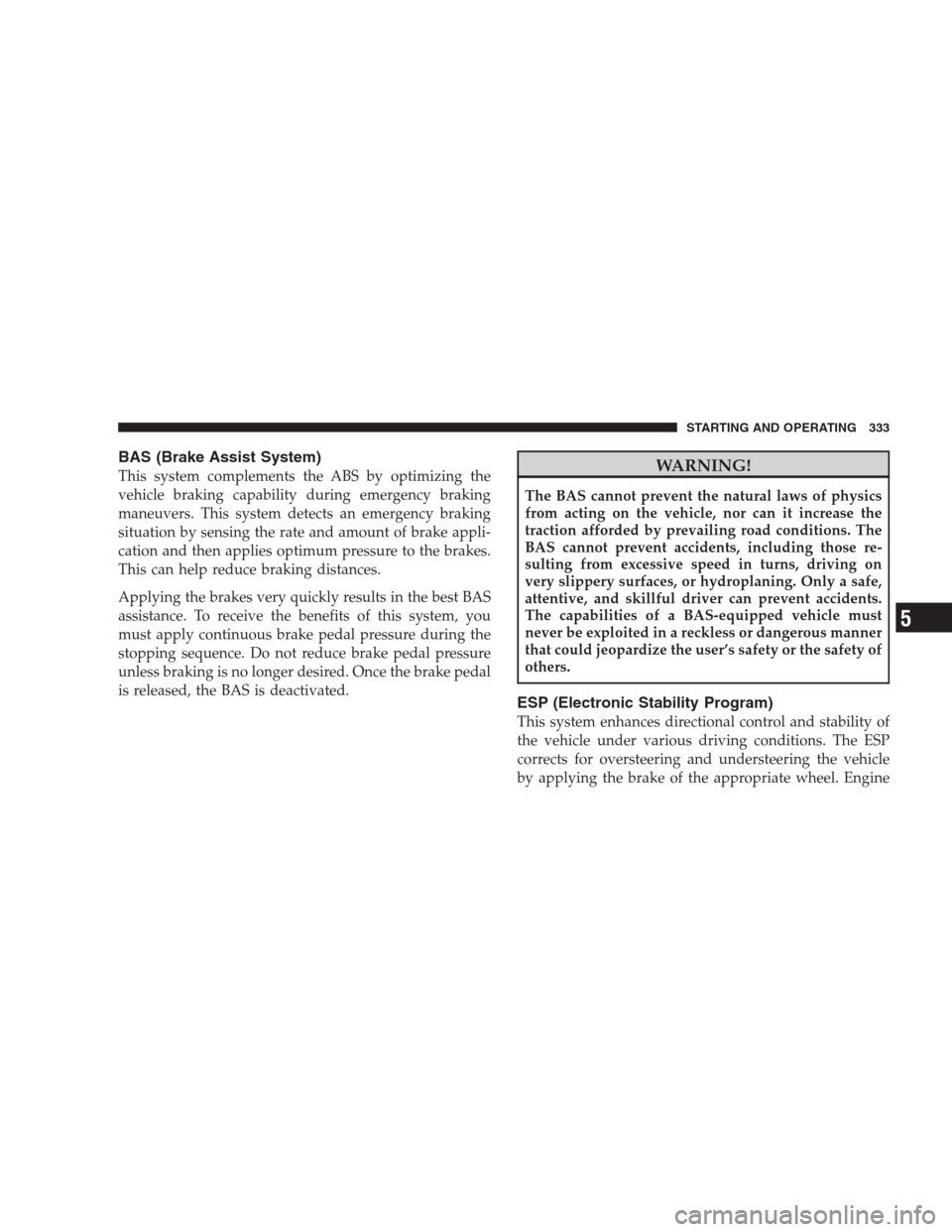
BAS (Brake Assist System)
This system complements the ABS by optimizing the
vehicle braking capability during emergency braking
maneuvers. This system detects an emergency braking
situation by sensing the rate and amount of brake appli-
cation and then applies optimum pressure to the brakes.
This can help reduce braking distances.
Applying the brakes very quickly results in the best BAS
assistance. To receive the benefits of this system, you
must apply continuous brake pedal pressure during the
stopping sequence. Do not reduce brake pedal pressure
unless braking is no longer desired. Once the brake pedal
is released, the BAS is deactivated.WARNING!
The BAS cannot prevent the natural laws of physics
from acting on the vehicle, nor can it increase the
traction afforded by prevailing road conditions. The
BAS cannot prevent accidents, including those re-
sulting from excessive speed in turns, driving on
very slippery surfaces, or hydroplaning. Only a safe,
attentive, and skillful driver can prevent accidents.
The capabilities of a BAS-equipped vehicle must
never be exploited in a reckless or dangerous manner
that could jeopardize the user’s safety or the safety of
others.
ESP (Electronic Stability Program)
This system enhances directional control and stability of
the vehicle under various driving conditions. The ESP
corrects for oversteering and understeering the vehicle
by applying the brake of the appropriate wheel. Engine
STARTING AND OPERATING 333
5
Page 336 of 493
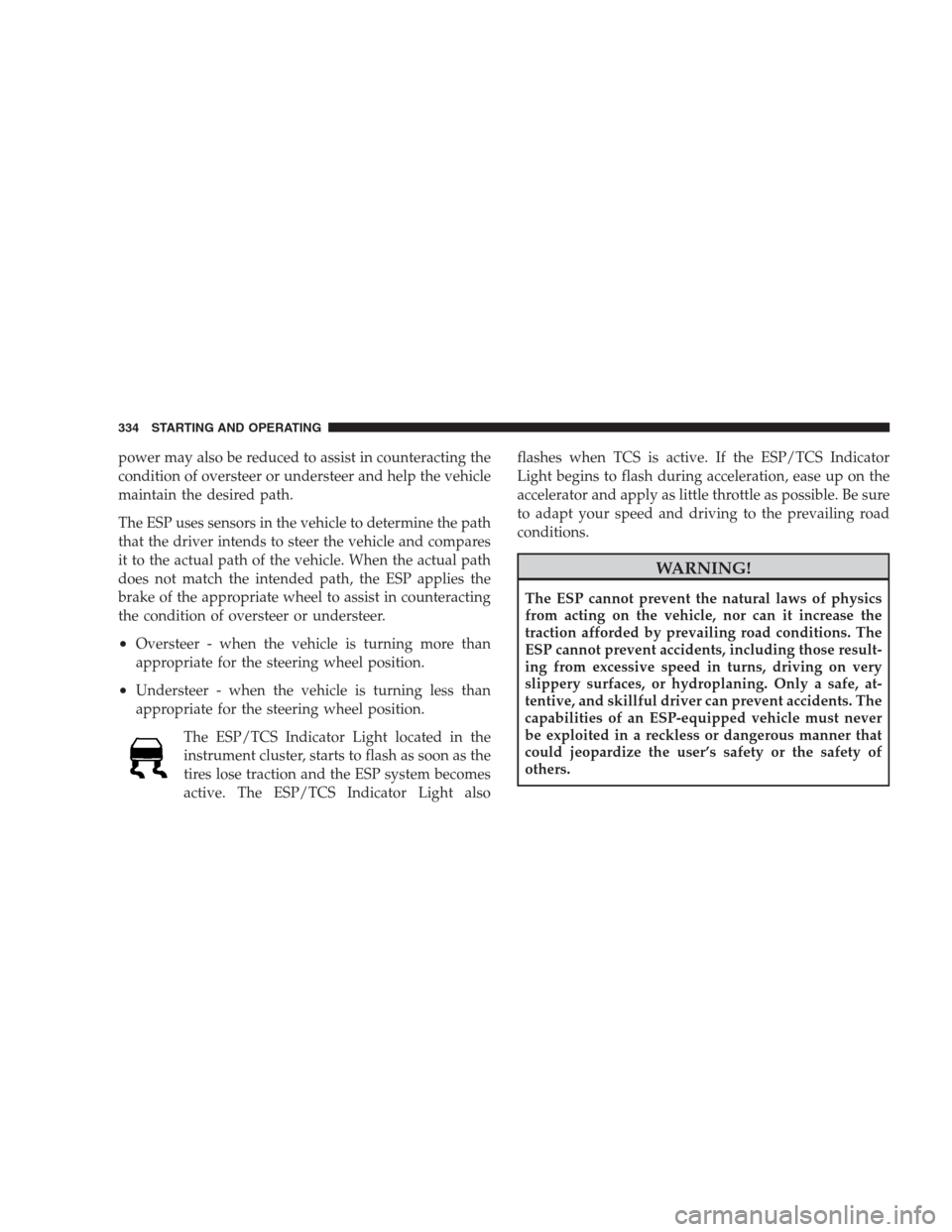
power may also be reduced to assist in counteracting the
condition of oversteer or understeer and help the vehicle
maintain the desired path.
The ESP uses sensors in the vehicle to determine the path
that the driver intends to steer the vehicle and compares
it to the actual path of the vehicle. When the actual path
does not match the intended path, the ESP applies the
brake of the appropriate wheel to assist in counteracting
the condition of oversteer or understeer.
•Oversteer - when the vehicle is turning more than
appropriate for the steering wheel position.
•Understeer - when the vehicle is turning less than
appropriate for the steering wheel position.
The ESP/TCS Indicator Light located in the
instrument cluster, starts to flash as soon as the
tires lose traction and the ESP system becomes
active. The ESP/TCS Indicator Light alsoflashes when TCS is active. If the ESP/TCS Indicator
Light begins to flash during acceleration, ease up on the
accelerator and apply as little throttle as possible. Be sure
to adapt your speed and driving to the prevailing road
conditions.
WARNING!
The ESP cannot prevent the natural laws of physics
from acting on the vehicle, nor can it increase the
traction afforded by prevailing road conditions. The
ESP cannot prevent accidents, including those result-
ing from excessive speed in turns, driving on very
slippery surfaces, or hydroplaning. Only a safe, at-
tentive, and skillful driver can prevent accidents. The
capabilities of an ESP-equipped vehicle must never
be exploited in a reckless or dangerous manner that
could jeopardize the user’s safety or the safety of
others.
334 STARTING AND OPERATING
Page 339 of 493

WARNING!
With the ESP switched OFF, the enhanced vehicle
stability offered by ESP is unavailable. In an emer-
gency evasive maneuver, the ESP system will not
engage to assist in maintaining stability. The “Full
Off” ESP mode is intended for off-highway or off-
road only.
Synchronizing ESP
The Malfunction Indicator Light for the ESP is
combined with BAS indicator. If the power
supply is interrupted (battery disconnected or
discharged), the ESP/BAS Malfunction Indica-
tor Light may illuminate with the engine running. If this
should occur, turn the steering wheel completely to the
left and then to the right. The ESP/BAS Malfunction
Indicator Light should go out. However, if the light
remains on, have the ESP and BAS checked at your
authorized dealer as soon as possible.
ESP/BAS Malfunction Indicator Light and
ESP/TCS Indicator Light
The Malfunction Indicator Light for the ESP is
combined with the BAS indicator. The yellow
ESP/BAS Malfunction Indicator Light and the
yellow ESP/TCS Indicator Light in the instru-
ment cluster both come on when the ignition switch is
turned to the ON position. They should go out with the
engine running.
The system will turn the ESP/BAS Malfunction Indicator
Light on continuously while the engine is running if it
detects a malfunction in either the ESP or the BAS or
both. If the light remains on after several ignition cycles
and you have driven the vehicle several miles (kilome-
ters) at speeds greater than 30 mph (48 km/h), and the
ESP is synchronized (refer to Synchronizing ESP), see
your authorized dealer as soon as possible to have the
problem diagnosed and corrected.
STARTING AND OPERATING 337
5
Page 355 of 493
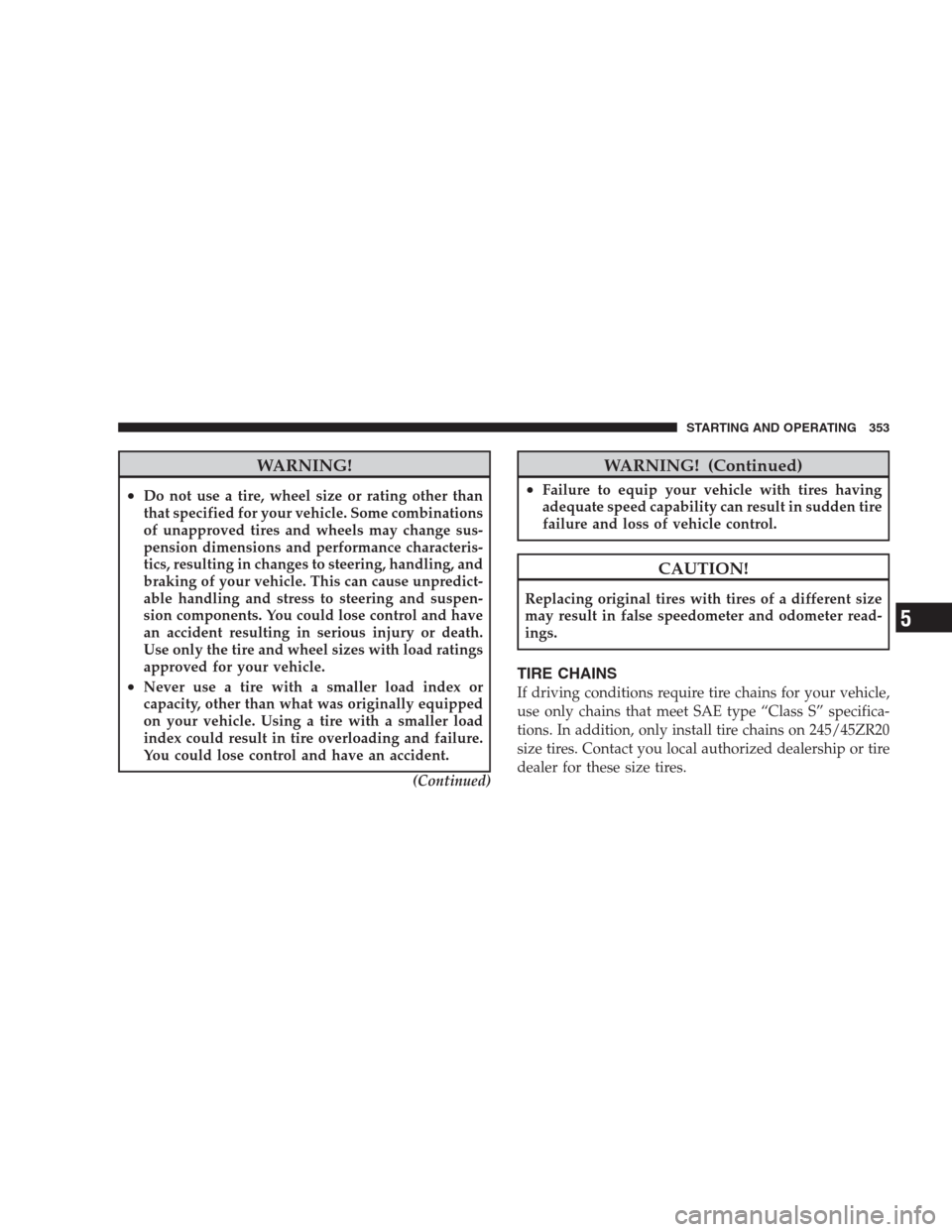
WARNING!
•Do not use a tire, wheel size or rating other than
that specified for your vehicle. Some combinations
of unapproved tires and wheels may change sus-
pension dimensions and performance characteris-
tics, resulting in changes to steering, handling, and
braking of your vehicle. This can cause unpredict-
able handling and stress to steering and suspen-
sion components. You could lose control and have
an accident resulting in serious injury or death.
Use only the tire and wheel sizes with load ratings
approved for your vehicle.
•Never use a tire with a smaller load index or
capacity, other than what was originally equipped
on your vehicle. Using a tire with a smaller load
index could result in tire overloading and failure.
You could lose control and have an accident.
(Continued)
WARNING! (Continued)
•Failure to equip your vehicle with tires having
adequate speed capability can result in sudden tire
failure and loss of vehicle control.
CAUTION!
Replacing original tires with tires of a different size
may result in false speedometer and odometer read-
ings.
TIRE CHAINS
If driving conditions require tire chains for your vehicle,
use only chains that meet SAE type “Class S” specifica-
tions. In addition, only install tire chains on 245/45ZR20
size tires. Contact you local authorized dealership or tire
dealer for these size tires.
STARTING AND OPERATING 353
5
Page 391 of 493
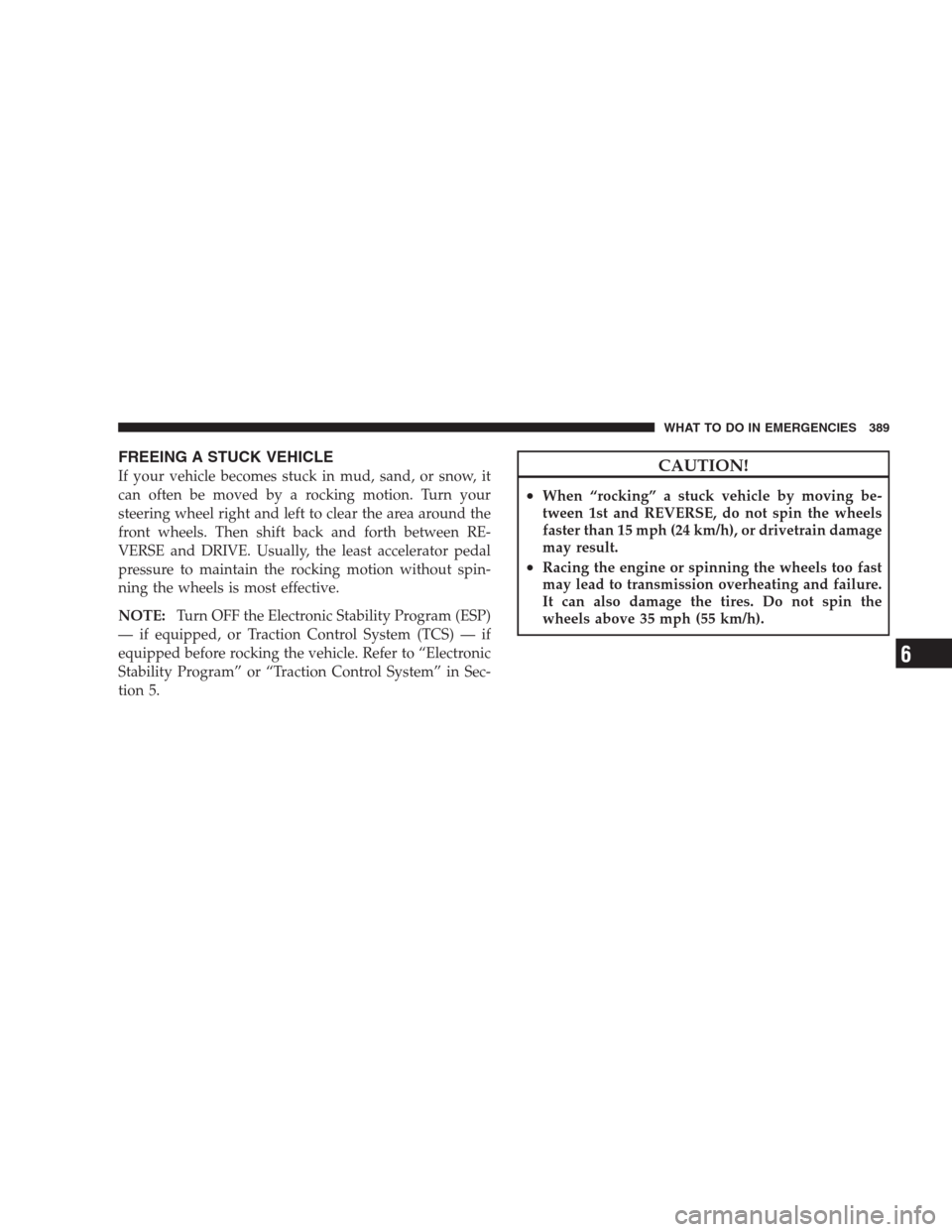
FREEING A STUCK VEHICLE
If your vehicle becomes stuck in mud, sand, or snow, it
can often be moved by a rocking motion. Turn your
steering wheel right and left to clear the area around the
front wheels. Then shift back and forth between RE-
VERSE and DRIVE. Usually, the least accelerator pedal
pressure to maintain the rocking motion without spin-
ning the wheels is most effective.
NOTE:Turn OFF the Electronic Stability Program (ESP)
— if equipped, or Traction Control System (TCS) — if
equipped before rocking the vehicle. Refer to “Electronic
Stability Program” or “Traction Control System” in Sec-
tion 5.CAUTION!
•When “rocking” a stuck vehicle by moving be-
tween 1st and REVERSE, do not spin the wheels
faster than 15 mph (24 km/h), or drivetrain damage
may result.
•Racing the engine or spinning the wheels too fast
may lead to transmission overheating and failure.
It can also damage the tires. Do not spin the
wheels above 35 mph (55 km/h).
WHAT TO DO IN EMERGENCIES 389
6
Page 474 of 493
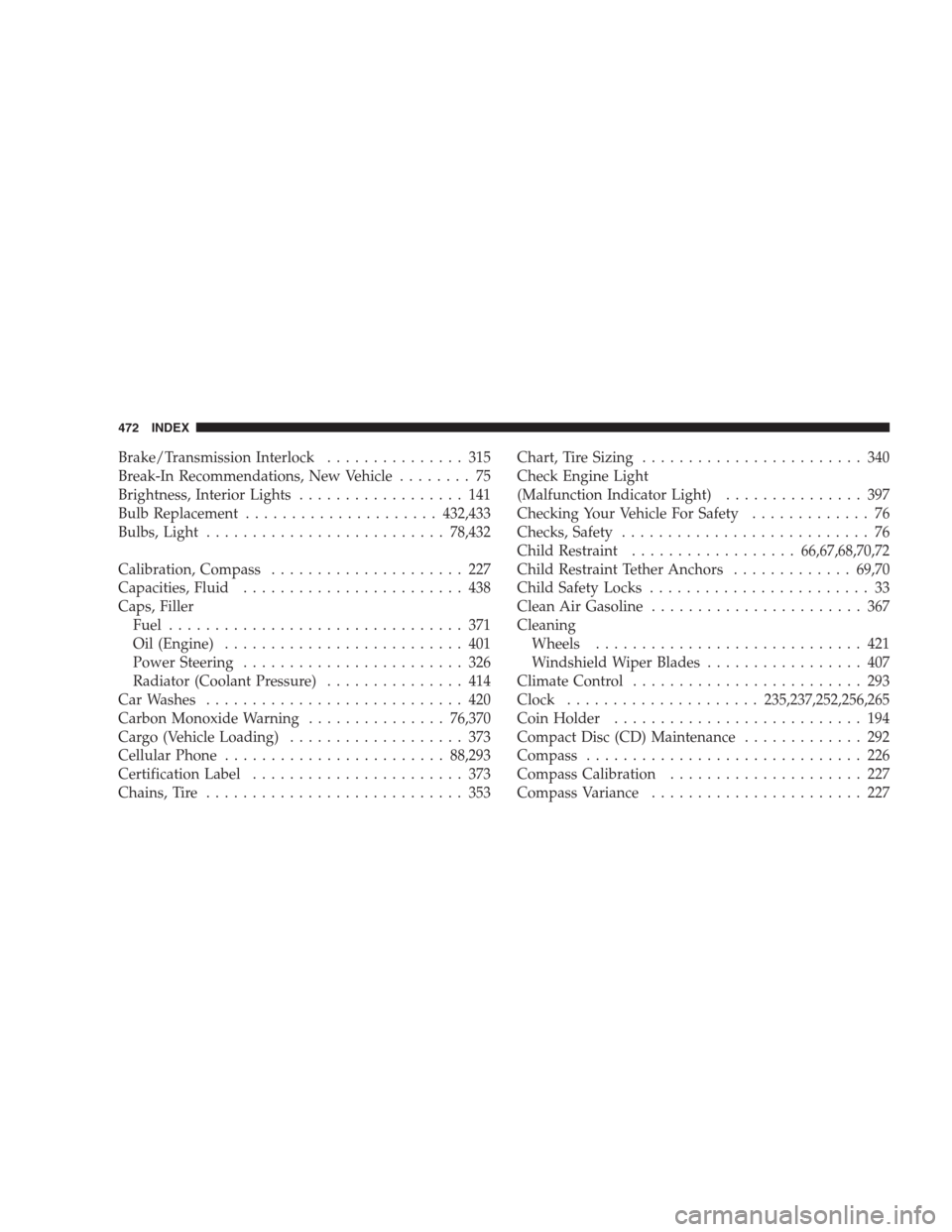
Brake/Transmission Interlock............... 315
Break-In Recommendations, New Vehicle........ 75
Brightness, Interior Lights.................. 141
Bulb Replacement.....................432,433
Bulbs, Light..........................78,432
Calibration, Compass..................... 227
Capacities, Fluid........................ 438
Caps, Filler
Fuel................................ 371
Oil (Engine).......................... 401
Power Steering........................ 326
Radiator (Coolant Pressure)............... 414
Car Washes............................ 420
Carbon Monoxide Warning...............76,370
Cargo (Vehicle Loading)................... 373
Cellular Phone........................88,293
Certification Label....................... 373
Chains, Tire............................ 353Chart, Tire Sizing........................ 340
Check Engine Light
(Malfunction Indicator Light)............... 397
Checking Your Vehicle For Safety............. 76
Checks, Safety........................... 76
Child Restraint..................66,67,68,70,72
Child Restraint Tether Anchors.............69,70
Child Safety Locks........................ 33
Clean Air Gasoline....................... 367
Cleaning
Wheels............................. 421
Windshield Wiper Blades................. 407
Climate Control......................... 293
Clock.....................235,237,252,256,265
Coin Holder........................... 194
Compact Disc (CD) Maintenance............. 292
Compass.............................. 226
Compass Calibration..................... 227
Compass Variance....................... 227
472 INDEX
Page 488 of 493

Steering
Column Controls...................... 138
Power.............................. 326
Tilt Column.......................... 146
Wheel, Tilt........................... 146
Steering Wheel Mounted Sound System
Controls.............................. 291
Storage............................194,431
Storage, Vehicle......................300,431
Storing Your Vehicle...................... 431
Stuck, Freeing.......................... 389
Sun Roof.............................. 187
Sunglasses Storage....................... 180
Sunroof Maintenance..................... 190
Supplemental Restraint System - Airbag........ 51
Synthetic Engine Oil...................... 402
System, Remote Starting.................... 25
Tachometer............................ 206Telescoping Steering Column............... 146
Temperature Control, Automatic (ATC)........ 294
Temperature Gauge, Engine Coolant.......209,379
Tether Anchor, Child Restraint............... 69
Theft Alarm (Security Alarm)................ 18
Theft System (Security Alarm)............... 18
Tilt Steering Column..................... 146
Time Delay, Headlight.................... 137
Tire and Loading Information Placard......... 343
Tire Identification Number (TIN)............. 342
Tire Markings.......................... 338
Tire Safety Information.................... 338
TIREFIT.............................. 380
Tires ............................78,347,466
Aging (Life of Tires).................... 351
Air Pressure.......................... 347
Chains.............................. 353
General Information.................... 347
High Speed.......................... 349
486 INDEX